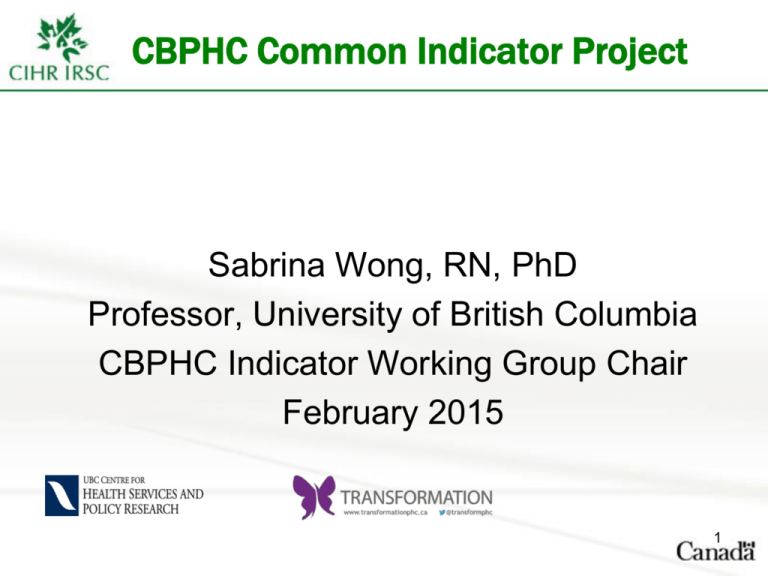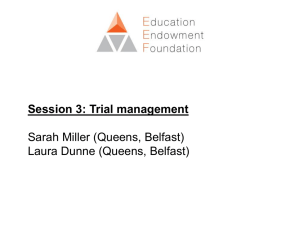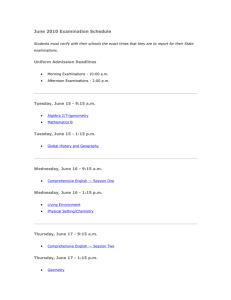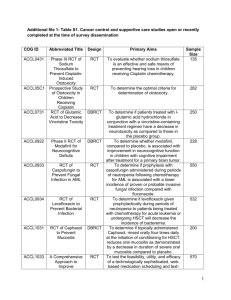patient survey data - University of British Columbia
advertisement

CBPHC Common Indicator Project Sabrina Wong, RN, PhD Professor, University of British Columbia CBPHC Indicator Working Group Chair February 2015 1 Questions being addressed by Indicators Working Group • What are the attributes of: (a) community based primary health care (CBPHC) innovations that address adult and child populations? (b) alternative models of chronic disease prevention and management in CBPHC on patient and system outcomes (e.g., health outcomes, cost, access, equity)? • What structures (e.g. governance, financing, etc.) and context influence the cost, implementation, delivery, scaleup and impact of PHC models of care? • What underlying methods, theories, or frameworks can be used to advance the science of comparative research? 2 Agreed upon Dimensions • Access (accommodation) • Comprehensiveness (primary health care support for self-management of chronic conditions, scope of services • Coordination (team functioning, system integration, information continuity, management continuity) • Effectiveness (self-efficacy, patient empowerment, patient centeredness, health and well-being, EQ5D5L) • Equity (horizontal and vertical) 3 Summary of Agreed upon Dimensions and Related Indicators Dimension/sub-dimension • Access (difficulty getting access, accommodation) • Comprehensiveness (PHC support for selfmanagement of chronic conditions, scope of services) • Coordination (team functioning, system integration, information continuity, management continuity) Indicator (CIHI and other) • Difficulties accessing routine or ongoing PHC • PHC support for selfmanagement of chronic conditions; Scope of PHC services • HC Team Effectiveness Score; Collaborative Care with other health care organizations 4 Summary of Agreed upon Dimensions and Related Indicators (2) Dimension/sub-dimension • Effectiveness (selfefficacy, patient empowerment, patient centredness, global health) • Equity (horizontalequality, vertical) Indicator (CIHI and other) • ACSC hospitalization rate, ED visits for asthmas; using patient reported impacts and outcomes of care • No CIHI indicators in CIHI PHC Update report; using pt. reported impacts and outcomes of care • Work in this area completed by researchers5 in Canada Coverage by Common Indicator across CBPHC Teams 6 Coverage by common indicator • Teams validated on ability to report on access, comprehensiveness, effectiveness, coordination, cost, equity and multimorbidity using the recommended common indicator and common measure/instrument 7 Data sources Source Qualitative interviews Patient surveys Administrative data Provider/practice surveys Cost data Organization survey Teams 12 10 9 7 7 5 8 Work to date • Agreement on: research questions, common dimensions of CBPHC, common indicators, common measures and data sources • Completed reviews of sampling, dimensions, indicators, and measures across teams • Working on mapping individual team’s work to expanded chronic care model; asking teams to develop their logic model 9 Coverage by common indicator *For “all teams” column, data was interpreted for the 2 non-validated teams. Domain Indicator Access Comprehensiveness *Difficulties accessing routine or ongoing PHC *PHC support for self-management of chronic conditions Comprehensiveness *Scope of PHC services Coordination Coordination *PHC team effectiveness score *Collaborative care with other healthcare organizations Effectiveness ACSC hospitalization rate Effectiveness Effectiveness Effectiveness Cost PROM: Functional health Self-efficacy for managing chronic disease Patient empowerment Direct (utilization) + indirect costs (e.g., out-of-pocket) Equity Multimorbidity N/A N/A 10 Next Steps • Overarching logic model • Analytic plan for common dimensions of CBPHC • Case study protocol 11 Extra information 12 Access: Difficulties accessing routine or ongoing PHC • 9/10 teams teams reported “Yes” Comments Team Grunfeld (Yes) Haggerty (Yes) Kaczorowski (Yes) Katz (Yes) Liddy (Yes) Ploeg (Yes) Stewart & Fortin (Yes) Wong (Yes) Young (Yes) • • • • • • In RCT N/A Patient survey within RCT With First Nations Regional Health Survey Patient survey in nurse practitioner-led clinics RCT 1 & RCT 2: In planned participant questionnaire • Can include in patient self-reported questionnaire, but do not expect changes • With questions recommended to 12 teams • Secondary analysis of existing CCHS data; question will be similar to the patient survey. 13 Comprehensiveness: PHC support for selfmanagement of chronic conditions • 10/10 teams reported “Yes” Comments Team Grunfeld (Yes) • In RCT Haggerty (Yes) Harris (Yes) • • N/A Could incorporate into the Readiness Tool provider survey and modify for relevance to indigenous populations. Could also use Clinical readiness tool or report qualitatively from clinical and community teams. • Kaczorowski (Yes) • Patient survey within RCT Katz (Yes) • N/A Liddy (Yes) • Patient survey and similar questions for patient centred medical home survey Ploeg (Yes) • RCT 1 & RCT 2: In planned participant questionnaire Stewart & Fortin (Yes) • Wong (Yes) • Young (Yes) • Could incorporate into baseline, but maybe not beyond N/A 14 Could incorporate within planned provider survey Comprehensiveness: Scope of PHC services • 6/10 teams reported “Yes,” 1 reported “Maybe” Team Haggerty (Yes) Harris (Yes) Katz (Yes) Liddy (Maybe) Ploeg (Yes) Wong (Yes) Young (Yes) Comments • N/A • Could incorporate into the Readiness Tool provider survey and modify for relevance to indigenous populations. • N/A • Will use patient-centred medical home org. survey, but willing to adapt or change if necessary. • RCT 1 & RCT 2: In practice questionnaire • N/A • Based on existing information 15 Coordination: PHC team effectiveness score • 9/10 teams reported “Yes,” 1 reported “Maybe” Team Grunfeld (Maybe) • Haggerty (Yes) Harris (Yes) • • Kaczorowski (Yes) Katz (Yes) Liddy (Yes) Ploeg (Yes) • • • • Stewart & Fortin (Yes) • Wong (Yes) Young (Yes) • • Comments Maybe in RCT: May want to include an oncologyspecific scale. Patient survey only. Information Continuity scale Could incorporate into the Readiness Tool provider survey and modify for relevance to indigenous populations. Patient survey within RCT N/A In patient survey RCT 1 & RCT 2: TCI 19 items; in practice questionnaire Can add the information continuity sub-scale to our patient questionnaire. N/A 16 Modified CIHI survey for own provider survey Coordination: Collaborative care with other healthcare organizations • 8/10 teams reported “Yes” Comments Team Harris (Yes) Haggerty (Yes) Kaczorowski (Yes) Katz (Yes) Liddy (Yes) Ploeg (Yes) Stewart & Fortin (Yes) Wong (Yes) • Could incorporate into the Readiness Tool provider survey and modify for relevance to indigenous populations. • Patient survey and organizational survey • Patient survey within RCT • N/A • Incorporated into patient survey • RCT 1 & RCT 2: In practice questionnaire • Not part of survey, but can incorporate within indepth provider interviews) • N/A 17 Effectiveness: ACSC hospitalization rate • 5/10 teams reported “Yes,” 1 reported “Maybe” Team Comments Grunfeld (Maybe) • RCT: Depends on conditions; will be measuring ED & hospitalizations associated w/chemotherapy toxicity. • Admin data: Likely yes, possibly in a few provinces • Expect to use admin data, but in QC Haggerty (Yes) Katz (Yes) Liddy (Yes) • Using an adapted version to be shared with the group. • Y for NL & ON cohort studies; TBC for ON Stewart & Fortin (Yes) • N/A Wong (Yes) • N/A 18 Effectiveness: Functional Health (VR-12) • 6/10 teams reported “Yes” Comments Team Grunfeld (Yes) • RCT Haggerty (Yes) • N/A Kaczorowski (Yes) • Incorporated into patient survey within RCT Liddy (Yes) • Likely in conjunction with CIHI patient planned survey; see if this has been validated with First Nations • Through patient survey Wong (Yes) • N/A Ploeg (No) • Using SF-12 Katz (Yes) Stewart & Fortin (No) • EQ-5D and SF-12 (could include PROMIS) 19 Effectiveness: Self-efficacy for managing chronic disease • 7/10 teams reported “Yes” Comments Team Grunfeld (Yes) • RCT: Likely if it passes face validity Haggerty (Yes) • N/A Kaczorowski (Yes) • Incorporated into patient survey within RCT Liddy (Yes) • Through patient survey Ploeg (Yes) • RCT 1 & RCT 2: In participant questionnaire Stewart & Fortin (Yes) • SE-MCD; can add Patient activation questions Wong (Yes) • N/A 20 Effectiveness: Patient empowerment • 5/10 teams reported “Yes” Team Comments Grunfeld (Yes) • RCT: If there is a breast cancer specific tool, would need to use that. Don't believe there is one. • Incorporated into patient survey within RCT Kaczorowski (Yes) • Could be incorporated, but concerned about response burden Stewart & Fortin (Yes) • N/A Liddy (Yes) Wong (Yes) • N/A 21 Cost: direct (utilization) + indirect costs (e.g. out-of-pocket) (will use EQ5D-5L) • 7/10 teams reported “Yes,” 1 reported “Maybe” Team Grunfeld (Yes) • • Comments Admin data if we link to admin data - from societal perspective, therefore need patient costs, but may need a cancer-specific one Collecting encounters during diagnostic, treatment and survivorship phase, and then cost out cancer services (possibly only ON) “Probably” will use Haggerty (Maybe) • Katz (Yes) • Liddy (Yes) • With admin data; but in First Nations communities, would really only have hospitalization data because other access is not captured. For NL & ON cohorts & possibly MB Ploeg (Yes) Stewart & Fortin (Yes) Wong (Yes) Young (Yes) • • • • RCT 1 & RCT 2: In participant questionnaire Plan to use admin data N/A Economic evaluation of patient transportation 22 Equity • 10/10 teams reported “Yes” Comments Team Grunfeld (Yes) Haggerty (Yes) • • Harris (Yes) • Kaczorowski (Yes) • N/A Katz (Yes) Liddy (Yes) • • Yes for some of the basic equity measures Yes for nurse practioner clinics (age, sex, gender, postal code, health ins #). Maybe in admin cohort studies through equity of access to care. Will have health ins # but might not have postal code. N/A • Ploeg (Yes) • Stewart & Fortin (Yes) Wong (Yes) Young (Yes) • • • RCT: 6-digit postal code Economic, immigrant/refugee status (specific ethnicities); aboriginal; age (young adult and elderly); rurality; residential stabiltiy; mental health Not using admin data, but from chart data can do sex/gender, age, geography in terms of province and degree of rural/remoteness. Will use gender, age and the Grunfeld questionnaire N/A 23 Existing databases on health status, determinants and utilization for Ab vs non-Ab and North vs South. Multimorbidity • 4/10 teams reported “Yes,” 3 reported “Maybe” Comments Team Grunfeld (Maybe) • Haggerty (Yes) Harris (Yes) • • • Katz (Maybe) • Liddy (Maybe) • Ploeg (Yes) • • Stewart & Fortin (Yes) RCT: Not sure if linking to admin data; otherwise, will embed within patient questionnaire (may use Martin's if relevant to population) Admin data: Jon Hopkins ADGs N/A Will capture most items from chart data but will not do a survey or admin data. Not sure about asking directly about the chronic conditions, and about others like TB, HIV, other mental health issues beyond depression & anxiety. Potential for NP study in patient questions (should HIV be added to increase comparability?). Will capture through admin data for cohorts. In patient questionnaire for RCT 1 & RCT 2 • N/A 24 Data sources possibilities 1 Asterisk denotes teams that have not been validated Bold texts denotes methods related to the common indicators *Audas 1. Administrative data (including cost), 2. Statistics Canada surveys, 3. Patient/family/provider interviews Grunfeld 1. Admin, lab, registry data, 2. Focus groups and interviews with patients and service providers Harris 1. National Community Profile survey 2. Community readiness tool (repeated measures), 3. Clinical readiness tool (repeated measures), 4. T2DM registry/surveillance data (chart audit), 5. Participant observation and interviews, 6. cost data Kaczorowski 1. Patient questionnaires (CANRISK) in pharmacy, 2. Admin data, 3. Focus groups & key informant interviews, 4. ChAMP database, patient EMRs, and patient surveys Katz 1. CIHI patient, provider, organization surveys, 2. administrative data (for ACSC hosp.), 3. qualitative case studies (sharing circles and focus groups), 4. service provider/administrator/manager interviews 25 Data sources possibilities 2 Haggerty Liddy Ploeg 1. International and national surveys (CMWF, QUALICOPC, CCHS), 2. interviews and focus groups with key stakeholders, 3. admin data, 4. patient and organizational questionnaires (EQ-5D, access measures, unmet need, quality care), 5. costs of implementation of intervention model 1. Admin, lab, registry, chart/clinical, HIV cohort data (including HRQoL like SF-36 for ON), 2. CIHI organizational survey, 3. semistructured interviews with PM stakeholders, 4. cost (billing data, ON case costing initiative) 1. Admin and population survey data (CCHS), 2. Semi-structured interviews with patients, family members, service providers, 3. family caregiver survey data (e.g., HRQoL, self efficacy, etc.), 4. Health and Social Services Inventory for utilization & cost data 26 Data sources possibilities 3 Stewart & Fortin 1. In-depth interviews with patients, providers, informal caregivers, decision makers regarding context, 2. admin data, 3. patient survey data, 4. cost data (admin data + CIHI Resource Intensity Weights) *Wodchis 1. QUALICOPC data from ON, QC, NZ at regional level, 2. organization, provider and patient survey and key informant interview data Wong 1. Modified CIHI patient, provider, organization surveys, 2. admin data, 3. clinical data (EMRs or chart), 3. case study data from interviews and focus groups on context Young 1. key informant interviews, 2. health centre and patient records & coroners' reports, 3. EMRs, 4. cost data 27




